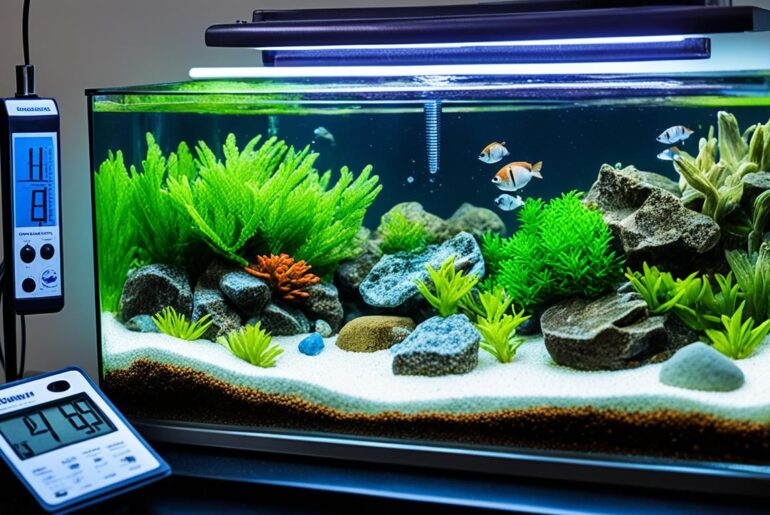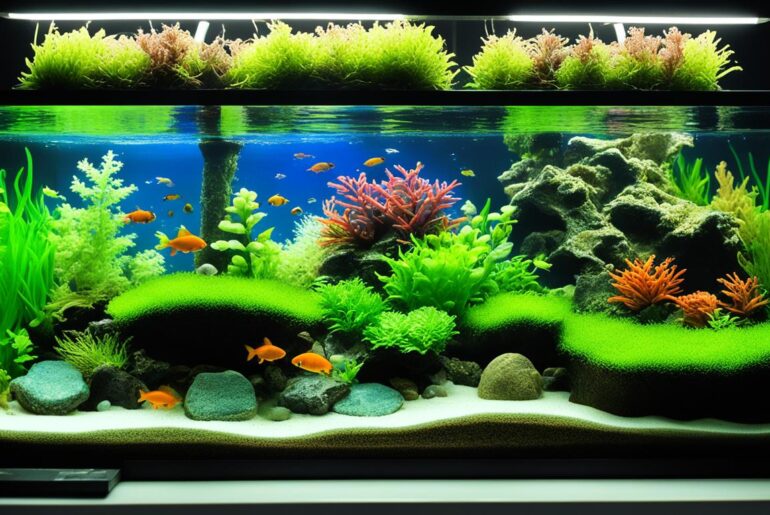As someone who has always been fascinated by the vibrant underwater world, I recently took the plunge and decided to set up my very own fish tank. Excitement filled my heart as I carefully selected colorful fish and adorned the tank with beautiful aquatic plants. But little did I know, there was a vital step I needed to undertake to ensure the well-being of my new aquatic companions – cycling the aquarium.
Just like us, fish require a safe and stable environment to thrive. That’s where aquarium cycling comes in. Cycling is the process of creating a biologically balanced ecosystem in your tank, where beneficial bacteria regulate the nitrogen cycle, converting harmful ammonia into less toxic forms. By cycling your aquarium before introducing fish, you can create a healthy and sustainable habitat that reduces stress and promotes optimal fish health.
Through my own experience and extensive research, I’ve learned valuable insights into the world of aquarium cycling. In this beginner’s guide, I’ll walk you through the essential steps to safely cycle your new aquarium with fish. Whether you’re a newbie or a seasoned fish enthusiast, this guide will equip you with the knowledge and tools to embark on a successful cycling journey.
Key Takeaways:
- By cycling your aquarium, you create a biologically safe environment for your fish.
- A well-cycled aquarium reduces stress, promotes fish health, and prevents harmful ammonia buildup.
- The cycling process typically takes four to eight weeks but can vary based on tank size, water pH, and temperature.
- There are three methods to cycle an aquarium: cycling without fish, cycling with fish, and cycling with plants.
- Properly monitoring and maintaining water parameters is crucial for a successful cycle.
What is the Aquarium Cycling?
Aquarium cycling is a crucial process for creating a biologically safe environment for fish in a new tank. It involves the introduction of nitrifying bacteria into the aquarium to establish and regulate the nitrogen cycle.
Nitrifying bacteria play a vital role in the cycling process by converting harmful ammonia into nitrite, and then nitrite into nitrate.
“The presence of nitrifying bacteria is essential for maintaining a healthy aquatic environment for fish.”
The nitrogen cycle is a natural biological process that ensures the breakdown and removal of toxic waste products from the fish, such as ammonia and nitrite. The conversion of these harmful substances into nitrate, a less toxic form, is crucial for the overall well-being of the aquarium inhabitants.
To better understand the importance of aquarium cycling, let’s take a closer look at the key components of the nitrogen cycle:
| Stage | Process |
|---|---|
| 1 | Ammonia |
| 2 | Nitrite |
| 3 | Nitrate |
Ammonia is the primary waste product produced by fish through respiration and the breakdown of organic matter. It is highly toxic and can be deadly to fish if not properly regulated. Nitrifying bacteria convert ammonia into nitrite, which is still toxic but less harmful than ammonia.
During the next stage, different nitrifying bacteria transform nitrite into nitrate. Nitrate is much less toxic to fish, although high levels can still harm them if not kept in check through regular water changes and maintenance.
Aquarium cycling is a continuous process, as ammonia is constantly being produced by the fish. The establishment of a healthy population of nitrifying bacteria is crucial to ensure the effective removal of ammonia and the maintenance of a stable and safe aquatic environment for the fish.
Next, we’ll explore why aquariums need to be cycled and the potential consequences of not cycling a tank before adding fish.
Why Do Aquariums Need to be Cycled?
Aquariums need to be cycled to create a biologically prepared environment for fish. Failing to cycle a new tank can lead to a condition known as new tank syndrome, which can have harmful effects on the fish due to built-up toxins.
One of the main reasons for cycling an aquarium is to prevent ammonia exposure. Ammonia is a byproduct of fish waste, and if it builds up in the tank, it can be extremely detrimental to fish health. A cycled aquarium creates a stable and balanced environment where beneficial bacteria convert ammonia into less harmful substances.
Fish that are not hardy or have a low tolerance to poor water conditions are particularly susceptible to ammonia exposure. Symptoms of ammonia exposure can include stress, lethargy, loss of appetite, and even death. By cycling an aquarium and maintaining proper water parameters, fish can live healthier lives and thrive in their aquatic environment.
Remember, a cycled aquarium is not only beneficial for the fish, but it also helps to maintain water quality and stability in the long run.
Understanding the importance of cycling an aquarium is essential for every fishkeeper. It lays the foundation for a healthy and thriving aquatic ecosystem that promotes the well-being of the fish and other inhabitants.
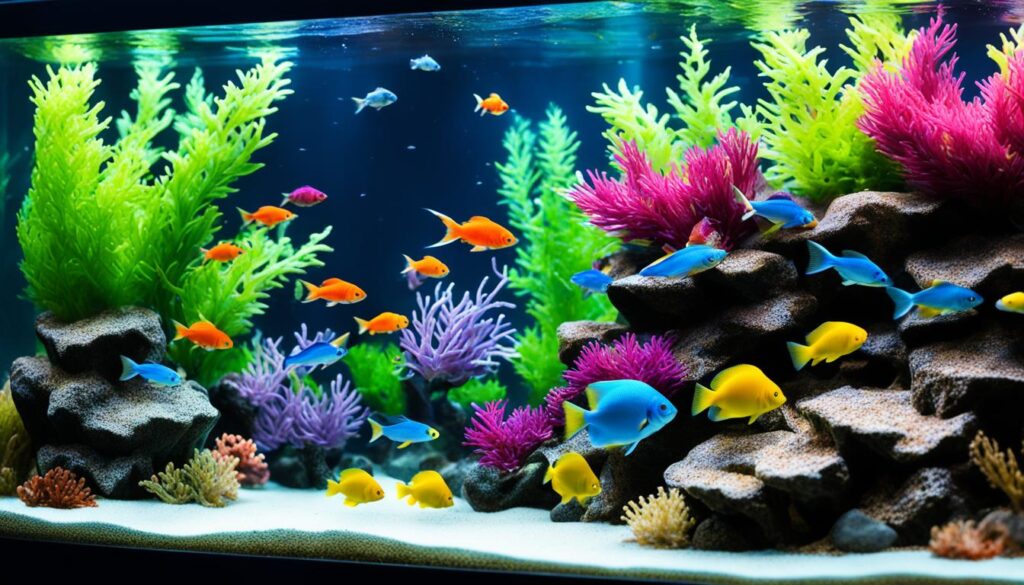
Don’t Skip the Cycling Process
It can be tempting to introduce fish to a new aquarium right away, but patience and proper preparation are key. Taking the time to cycle the tank will establish a biologically stable environment and create the ideal conditions for fish to thrive.
Benefits of a Cycled Aquarium
- Provides a safe and healthy environment for fish
- Prevents new tank syndrome
- Reduces the risk of ammonia exposure
- Promotes optimal fish health and well-being
- Maintains water quality and stability
Next Section: How Long Does an Aquarium Take to Cycle?
How Long Does an Aquarium Take to Cycle?
Cycling an aquarium is a crucial process to create a safe and healthy environment for your fish. It generally takes four to eight weeks for an aquarium to cycle, but the exact time can vary depending on several factors.
The cycling time of an aquarium is influenced by various factors such as tank size, water pH, water temperature, and the levels of ammonia, nitrite, and nitrate in the water. Monitoring and maintaining these factors can help expedite the cycling process.
To ensure a successful cycle, it is important to regularly test the water for ammonia, nitrite, and nitrate levels every one to two days. This will help you keep track of the progress and make any necessary adjustments.
During the cycling process, the goal is to reach a point where the levels of ammonia and nitrite drop to zero, and nitrates start to be produced. This indicates that the beneficial bacteria responsible for breaking down harmful substances are established and functioning properly in the aquarium.
By maintaining stability in water parameters and regularly testing the water, you can ensure that your aquarium is cycling effectively and creating a safe environment for your fish.
What Do I Need to Cycle an Aquarium?
When it comes to cycling an aquarium, having the right supplies is essential for success. Here are the key items you’ll need:
- Fish food: Fish food is used to raise the ammonia levels in the tank during the cycling process. It serves as a source of organic matter that produces ammonia, which is necessary for the growth of beneficial bacteria.
- Aquarium test kit: An aquarium test kit is your go-to tool for monitoring the levels of ammonia, nitrite, and nitrate in the tank. Regular testing ensures that the nitrogen cycle is progressing as it should and helps you maintain a healthy environment for your fish.
- Tank components: Make sure you have all the necessary tank components, such as a suitable substrate, decor, and adequate filtration system. These components provide a conducive environment for beneficial bacteria to thrive and aid in maintaining water quality.
- Water filter: A quality water filter is crucial for removing contaminants from the water, such as chlorine and chloramine. Opting for a filter that utilizes reverse osmosis (RO) water can further enhance the water quality in your tank.
- Reverse osmosis water: Reverse osmosis water is recommended for use in aquariums as it helps eliminate impurities and ensures a clean and safe environment for your fish. It is an excellent choice for reducing the likelihood of unwanted chemicals or minerals affecting the cycling process.
- pH test strips: Monitoring and maintaining the water’s pH levels is vital during the cycling process. pH test strips or an all-in-one test kit can assist you in keeping the pH within the optimal range for the health and well-being of your fish.
By having these essential items on hand, you’ll be well-prepared to initiate and monitor the cycling process of your aquarium, creating a safe and thriving habitat for your fish.
How to Cycle an Aquarium Without Fish
When it comes to cycling an aquarium, one popular and humane method is fishless cycling. This approach allows you to create a safe and healthy environment for your future fish without subjecting them to potential stress and harm. Here’s how you can successfully cycle your aquarium without fish:
1. Set up the tank
Before starting the cycling process, make sure to set up all the necessary components of your aquarium. This includes the pumps, filters, substrate, and any other equipment required for the proper functioning of the tank.
2. Maintain the water’s pH
Keeping the water’s pH level within the ideal range is crucial during the cycling process. Aim for a pH between 7.0 and 7.8, as this is the optimal range for most aquarium fish.
3. Monitor ammonia, nitrite, and nitrate levels
Regularly test the ammonia, nitrite, and nitrate levels in your aquarium using a reliable testing kit. This will help you keep track of the progress of the nitrogen cycle. Aim to maintain a stable ammonia level throughout the process.
4. Add ammonia to kickstart the nitrogen cycle
To initiate the nitrogen cycle, you’ll need to introduce a source of ammonia into the tank. This can be achieved by adding fish food or pure ammonia drops. Start with a small amount and monitor the ammonia levels to ensure they remain within the desired range.
5. Check and regulate ammonia and nitrite levels
Regularly check the ammonia and nitrite levels in your aquarium. As the bacteria colonize and establish themselves, you’ll notice an increase in the levels of nitrite. Keep monitoring and adjusting the ammonia and nitrite levels until nitrate becomes detectable.
6. Complete the cycle
The fishless cycling process is considered complete once the ammonia and nitrite levels reach 0 ppm and nitrate levels are detectable. This indicates that the beneficial bacteria have successfully established themselves and are converting harmful ammonia and nitrite into less toxic nitrate.
Once you have completed the fishless cycling process, you can slowly introduce fish to your tank, ensuring they can thrive in a well-established and healthy environment.
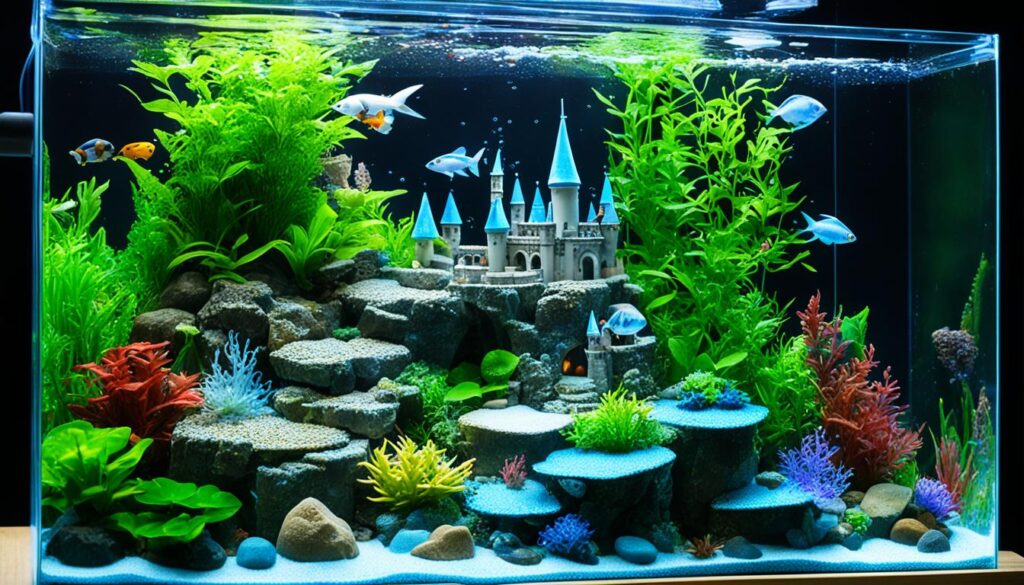
| Cycling Step | Description |
|---|---|
| Set up the tank | Install all necessary components and equipment in your aquarium |
| Maintain the water’s pH | Keep the water’s pH level between 7.0 and 7.8 |
| Monitor ammonia, nitrite, and nitrate levels | Regularly test the levels using a reliable testing kit |
| Add ammonia to kickstart the nitrogen cycle | Introduce a source of ammonia like fish food |
| Check and regulate ammonia and nitrite levels | Monitor and adjust levels until nitrate is detectable |
| Complete the cycle | When ammonia and nitrite levels reach 0 ppm and nitrate levels are detectable |
How to Cycle an Aquarium With Fish
To cycle an aquarium with fish, follow these steps:
- Set up the tank’s components such as the filter, heater, substrate, and decorations.
- Add a few hardy fish to the tank. Hardy fish, such as guppies or mollies, can withstand the cycling process better than other sensitive species.
- Feed the fish lightly at first, gradually increasing the amount of food over time. This will ensure that they produce enough ammonia to kickstart the nitrogen cycle.
- Regularly test the water quality using ammonia test strips and multi-test strips. This will help monitor the levels of ammonia and nitrite in the tank.
- If detectable amounts of ammonia or nitrite are present, perform water changes to dilute these harmful substances and maintain water quality.
- The cycle is considered complete when the ammonia and nitrite levels consistently stay at 0 ppm (parts per million), and nitrate levels are above 0 ppm.
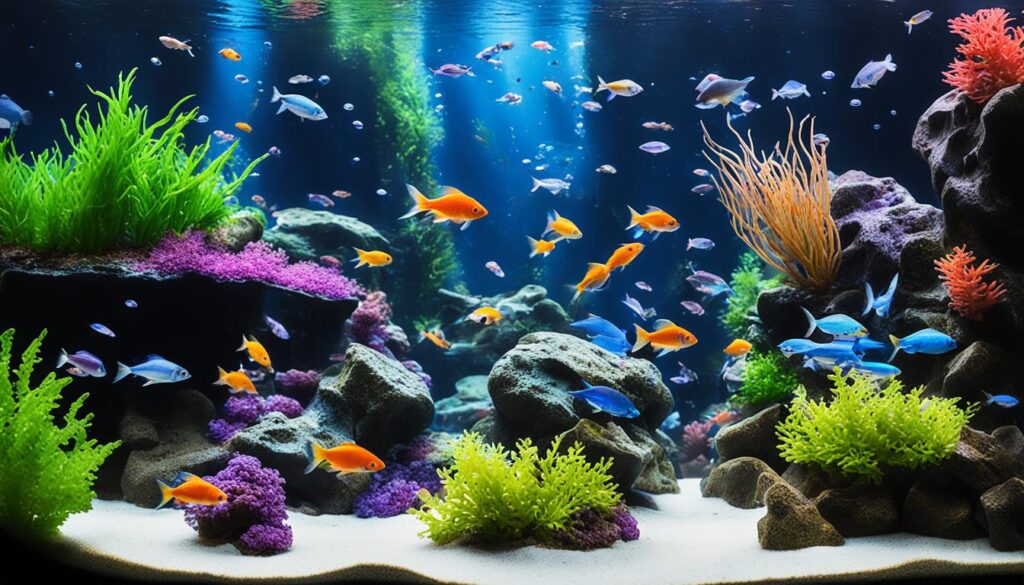
Cycling an aquarium with fish allows the nitrogen cycle to occur naturally while the fish contribute to the cycling process. By following these steps, you can establish a balanced and healthy environment for your fish.
How to Cycle an Aquarium With Plants
Cycling an aquarium with plants is an excellent method for creating a healthy and natural environment for your fish. By incorporating live aquarium plants into your tank from the beginning, you can enhance the cycling process and provide multiple benefits for your aquatic ecosystem.
One of the key advantages of plant cycling is that live aquarium plants consume nitrogen waste more effectively than bacteria. As plants grow, they absorb ammonia and convert it into essential nutrients, such as nitrates, through a process called nitrogen fixation. This helps to maintain optimal water conditions by reducing the levels of harmful ammonia and nitrite.
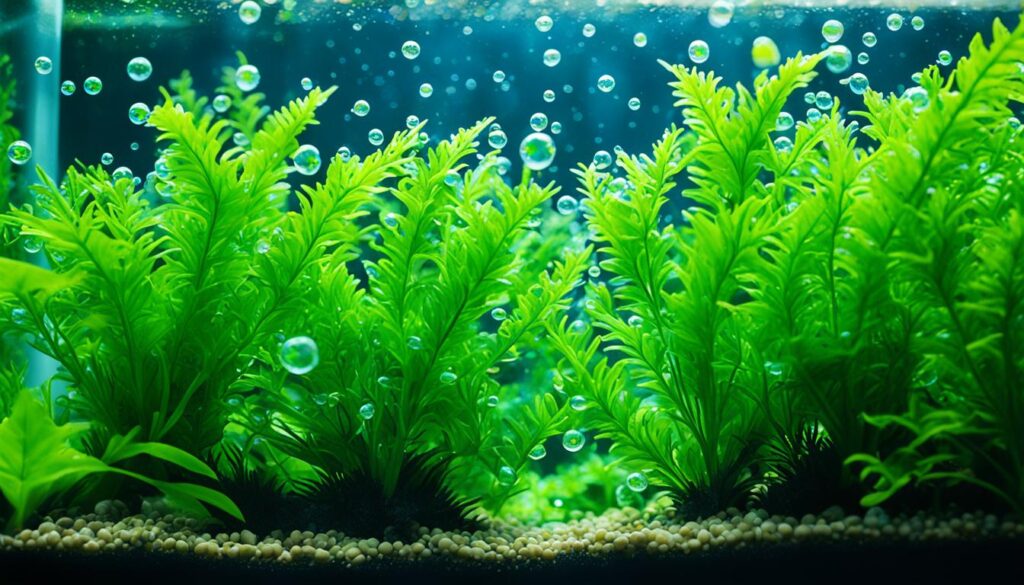
To cycle an aquarium with plants, follow these steps:
- Start by adding a variety of live aquarium plants to your tank. Choose plants that are suitable for your aquarium size, lighting conditions, and water parameters.
- Allow the plants to establish and show new growth before introducing any fish. This typically takes around 2-4 weeks.
- Monitor the water quality using a reliable water test kit. It is crucial to ensure that ammonia and nitrite levels remain at 0 ppm, while keeping nitrate levels below 40 ppm.
- If ammonia or nitrite levels exceed the safe range, consider performing partial water changes to maintain a healthy environment for your plants and fish.
- Once the nitrogen cycle is stable, you can gradually introduce a few fish to your planted tank. Start with small, hardy fish that can withstand any residual ammonia or nitrite in the water.
Remember to continue monitoring the water parameters regularly to maintain the balance of the nitrogen cycle. Adding a mix of fast-growing and slow-growing plants can further improve the overall water quality and create a visually pleasing aquarium.
Conclusion
After exploring the intricacies of aquarium cycling, it becomes evident that this process is crucial for creating a safe and healthy environment for your fish. The nitrogen cycle, with its stages of ammonia, nitrite, and nitrate, plays a vital role in maintaining water quality and preventing harmful ammonia buildup.
Fortunately, there are multiple cycling methods available, allowing you to choose the one that best suits your preferences and resources. Whether you opt for cycling without fish, fish-in cycling, or cycling with plants, each method has its own unique benefits.
Regardless of the method, it is crucial to follow the proper steps and consistently monitor water parameters throughout the cycling process. Testing levels of ammonia, nitrite, and nitrate on a regular basis will help ensure the success of your aquarium cycle.
By taking the time and effort to cycle your aquarium, you provide your fish with a safe and stable habitat, ensuring their well-being and longevity. So, get ready to create a thriving underwater world, and embark on the rewarding journey of aquarium ownership.
FAQ
What is aquarium cycling?
Aquarium cycling is the process of creating a biologically safe environment for fish in a new tank by introducing nitrifying bacteria to regulate the nitrogen cycle.
Why do aquariums need to be cycled?
Aquariums need to be cycled to create a biologically prepared environment for fish and prevent new tank syndrome, which can be harmful to fish due to built-up toxins.
How long does an aquarium take to cycle?
An aquarium generally takes four to eight weeks to cycle, but the time can vary depending on factors such as tank size, water pH, and temperature.
What do I need to cycle an aquarium?
To cycle an aquarium, you will need fish food, an aquarium test kit, all necessary tank components, a quality water filter, and reverse osmosis water.
How to cycle an aquarium without fish?
To cycle an aquarium without fish, set up the tank’s components, maintain the water’s pH between 7.0 and 7.8, and monitor the ammonia, nitrite, and nitrate levels during the cycling process. Add ammonia to kickstart the nitrogen cycle and introduce fish slowly once the cycle is complete.
How to cycle an aquarium with fish?
To cycle an aquarium with fish, set up the tank’s components, add a few hardy fish, feed them lightly at first, and gradually increase the amount over time. Test the water quality using ammonia test strips and perform water changes when detectable amounts of ammonia or nitrite are present. The cycle is complete when ammonia and nitrite levels stay at 0 ppm and nitrate levels are above 0 ppm.
How to cycle an aquarium with plants?
To cycle an aquarium with plants, add live aquarium plants to the tank from the beginning. The plants consume nitrogen waste more effectively than bacteria. Gradually add a few fish to the tank once the plants show new growth. Monitor water quality using a water test kit and ensure ammonia and nitrite levels are at 0 ppm, and nitrates are below 40 ppm.
What is the conclusion of aquarium cycling?
Aquarium cycling is essential for creating a safe and healthy environment for fish. The nitrogen cycle plays a crucial role in maintaining water quality and preventing harmful ammonia buildup. There are different methods to cycle an aquarium, including cycling without fish, fish-in cycling, and cycling with plants. Following the proper steps and monitoring water parameters during cycling is crucial for the success of the cycle. By cycling your aquarium, you can ensure the well-being and longevity of your fish.

